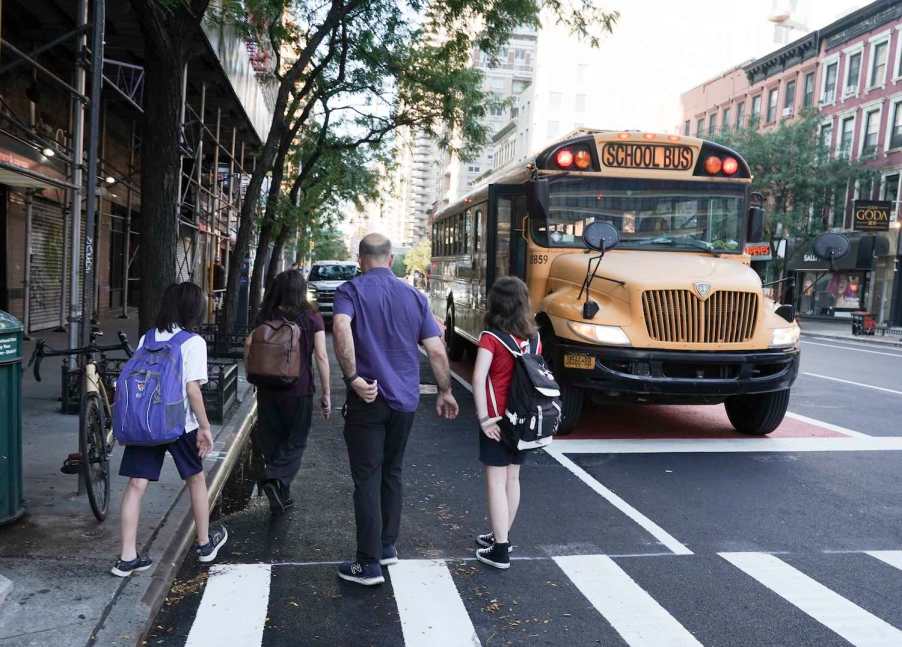
In 1 State It’s Illegal to Pass a Parked School Bus–Under Any Conditions!
In New York State, you can’t pass a stopped school bus. And that makes sense for everyone’s safety. But New York’s bus stopping laws apply even if the bus is on the opposite side of a divided highway, across eight lanes of rush hour traffic. So do New York State bus drivers expect students to play “Frogger” across multiple lanes of traffic to get home? Read on for the details.
School bus stopping laws for motorists vary by state

Nobody wants to put the students riding a school bus in danger. So, in every state, nearby traffic must stop when a school bus stops to drop off or load passengers. These bus stopping laws apply to every car behind the bus and oncoming traffic on a two-lane road.
Some states specify that you must stop 20 or even 30 feet behind a stopped bus. Other states clarify that you can’t move again until the bus driver shuts off their red blinking lights. Still others specify that you must wait until the bus begins to move again.
One way bus stopping laws vary by state is when you need to stop for a school bus stopped in oncoming traffic. Every state agrees that when a bus stops on a two-lane road, traffic should stop in both directions. And this makes sense: few bus drivers will make a U-turn to drop a student off on their front lawn when they could let them off on the opposite side of a two-lane street.
That said, multiple states specify that you don’t need to stop when a school bus stops on the opposite side of a four-lane road (and in Ohio and Washington the bus law is just three lanes). More states relax their laws around roads larger than four lanes. And most states don’t require you to stop when a bus is on the opposite side of a divided highway–which is usually defined by an untraversable obstacle, such as a raised grass median or Jersey barrier.
New York has very strict school bus stopping laws

In New York State, you must stop for a stopped bus anywhere on the same road as you. This includes multi-lane roads of any size–and divided highways.
If you are driving in New York State and see a school bus flip out its stop sign and/or flash its red lights, you must stop. This includes a bus on the road you’re driving, in front of a school, or in a parking lot. You also must stop at least 20 feet away from the bus.
So what if the bus is driving towards you? You still must stop. New York does not write any exceptions into this law, even for multi-lane roads. So if a school bus is traveling in the opposite direction, eight lanes away from you, you are legally obligated to stop. This is important to know while driving through NY because local drivers may pump the brakes when you wouldn’t expect them to in your home state.
There are only three states that have bus stopping laws requiring you to stop for a school bus stopped on the other side of any “divided” highway. These are West Virginia, Mississippi, and New York State. In Arkansas, you need to stop for a school bus parked on the far side of a divided highway–if the median is less than 20 feet wide.
On a non-divided highway in Mississippi, you only have to stop for a school bus coming the other way if the road is less than four lanes wide. You also don’t need to stop on a controlled-access highway or if the bus has pulled off completely, into a loading zone in a place pedestrians can’t cross your lane. West Virginia’s only exception is if a school bus, for some reason, stops to drop off passengers on an Interstate Highway. In this case, oncoming traffic does not need to stop.
Find out the school bus stopping laws in your state
It is obviously important that we all look out for students getting on or off of a school bus. But it is also important not to rear-end other drivers when they pump the brakes for a school bus stopped on the opposite side of a multi-lane road. So be sure to know your local laws below.
Next, see the school bus passing laws in all 50 states, or see what happens when drivers ignore bus stopping laws and pass a school bus illegally in the video below:







